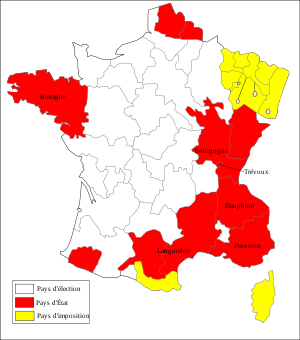Pays d'états
Under the Ancien Régime, a pays d'états (French pronunciation: [pei deta]) was a type of généralité, or fiscal and financial region where, in contrast to the pays d'election, an estates provincial or representative assembly of the three orders had retained its traditional role of negotiating the raising of taxes with the royal commissaires or intendants, dividing the tax burden by diocese and parish, and controlling tax collection. The estates also held onto part of the funds thus raised to repair and develop the roads in its province.

In red, the pays d'états in 1789
According to Roland Mousnier[1] and Bernard Barbiche[2] the pays d'états were:
- Alsace. Estates suppressed - 17th century
- Anjou. Estates suppressed - 15th century
- Artois. Estates suppressed - 1789.
- Auvergne. Estates suppressed - 17th century
- Basse-Navarre. Estates suppressed - 1789.
- Béarn. Estates suppressed - 1789.
- Berry. Estates suppressed - 16th century
- Bigorre. Estates suppressed - 1789.
- Bourgogne (Burgundy). Estates suppressed - 1789.
- Bresse. Estates suppressed - 1789.
- Bretagne (Brittany). Estates suppressed - 1789.
- Bugey. Estates suppressed - 1789.
- Cambrésis. Estates suppressed - 1789.
- Charolais. Estates suppressed - 1789.
- Corse (Corsica). Estates suppressed - 1789.
- Dauphiné. Estates suppressed - 17th century
- Flandre (Flanders). Estates suppressed - 1789.
- Foix. Estates suppressed - 1789.
- Franche-Comté. Estates suppressed - 18th century
- Gévaudan. Estates suppressed - 1789.
- Hainaut (Hainault). Estates suppressed - 1789.
- Labourd. Estates suppressed - 1789.
- Languedoc. Estates suppressed - 1789.
- Limousin. Estates suppressed - 15th century
- Mâconnais. Estates suppressed - 1789.
- Maine. Estates suppressed - 16th century
- Marche. Estates suppressed - 15th century
- Marsan. Estates suppressed - 1789.
- Nébouzan. Estates suppressed - 1789.
- Normandie (Normandy). Estates suppressed - 17th century
- Orléanais. Estates suppressed - 16th century
- Périgord. Estates suppressed - 16th century
- Provence. Estates suppressed - 1789.
- Quatre-Vallées. Estates suppressed - 1789.
- Quercy. Estates suppressed - 17th century
- Rouergue. Estates suppressed - 17th century
- Soule. Estates suppressed - 1789.
- Touraine. Estates suppressed - 16th century
- Velay. Estates suppressed - 1789.
- Vivarais. Estates suppressed - 1789.
Notes and references
- Les institutions de la France sous la monarchie absolue, 1598-1789, PUF, Paris, 2005
- Les institutions de la Monarchie française à l’époque moderne, XVIe-XVIIIe siècle, PUF, Paris, 1999)
gollark: You can use that then run it through `ffmpeg` to get an MP3, if you need *mp3*.
gollark: Do you need mp3 specifically or audio generally?
gollark: That is NOT funny™.
gollark: NO!
gollark: Funny™.
See also
- Subdivisions of France under the Ancien Régime
This article is issued from Wikipedia. The text is licensed under Creative Commons - Attribution - Sharealike. Additional terms may apply for the media files.